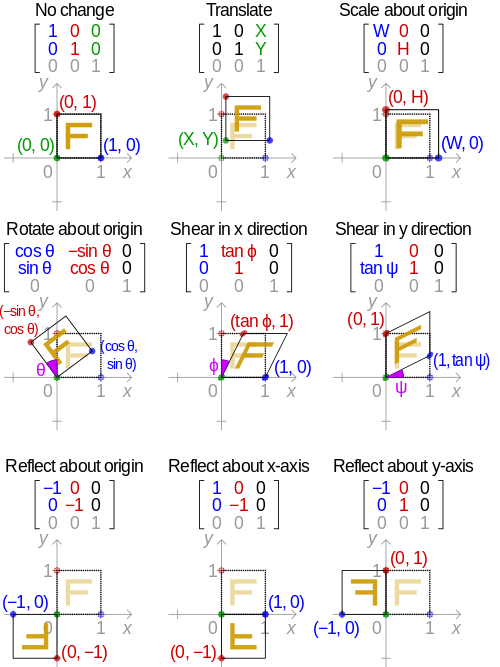Affine, Perspective Transformation

1 仿射变换
仿射变换是在二维空间上对图像进行平移、缩放、旋转、shear 和镜像5个操作的组合。
仿射变换后,相交线之间的角度可能发生变化(shear),但平行线之间的关系保持不变。
因为仿射变换是在二维空间中进行的,所以至少需要3个点才能构造一个 $2\times3$ 的仿射变换矩阵。
仿射变换矩阵中各个元素的作用见下图:

求出仿射变换矩阵 $M$ 后,与点 $P(x, y)$ 进行矩阵乘法,就得到仿射变换后的点 $P’(x’,y’)$。
\[M \cdot \begin{bmatrix} x\\y\\1 \end{bmatrix}= \begin{bmatrix} x'\\y' \end{bmatrix}\]- 将点 $p(0,0)$ 通过仿射变换矩阵在 $x,y$ 方向上分别平移1,2个单位。
- 将点 $p(0,1)$ 通过仿射变换矩阵绕原点旋转$90^{\circ}$。
2 透视变换
“一个简单的例子,你用手电筒往墙上打光。
如果手电筒和墙面垂直,打出来的光是圆,有倾斜角度就是椭圆。离墙面近光环就小点,离得远光环就大点。
但手电筒本身是固定不变的,只是不同的透视变换有不同的结果。”
透视变换就是通过投影的方式,把当前平面上的图像映射到另外一个平面。
因为透视变换是在三维空间中进行的,所以至少需要4个点才能构造一个一个 $3\times3$ 的透视变换矩阵。
透视变换矩阵没有直观的理解,就不做解释辽。
3 OpenCV中调用
import cv2 as cv
import numpy as np
import matplotlib.pyplot as plt
img = cv.imread('circle.jpg')
# affine
pts1 = np.float32([[0,0], [3200,0], [0,3200]])
pts2 = np.float32([[2400,200], [3200,0], [0,3200]])
M = cv.getAffineTransform(pts1,pts2)
dst = cv.warpAffine(img,M,(3200,3200))
plt.imshow(dst, cmap=plt.cm.gray)
plt.show()
# perspective
pts1 = np.float32([[0,0], [3200,0], [0,3200], [3200, 3200]])
pts2 = np.float32([[800,200], [3200,0], [0,3200], [3000, 3000]])
M = cv.getPerspectiveTransform(pts1,pts2)
dst = cv.warpPerspective(img,M,(3200,3200))
plt.imshow(dst, cmap=plt.cm.gray)
plt.show()
Reference
[1] Wikipedia Affine transformation